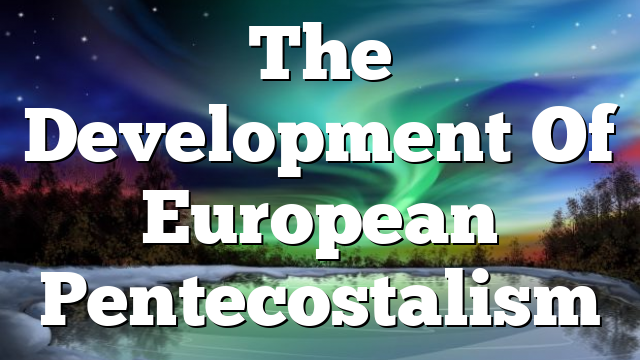Click to join the conversation with over 500,000 Pentecostal believers and scholars
Click to get our FREE MOBILE APP and stay connected
| PentecostalTheology.com



1 The Development of European Pentecostalism The origin of Pentecostalism in Europe is easily traceable to the influ- ence of the Apostolic Faith Mission at 312 Azusa Street in Los Angeles, California. It came when a series of “missionaries” from Azusa Street converged in New York City and met a Methodist .. missionary-pastor from Norway, Thomas Ball Barratt. Pastor Barratt was in the city on an extended fund-raising tour. While staying at the Alliance Home there, he first heard about the events in Los Angeles by reading The Apostolic Faith and/or the Way of Faith, both of which carried the news. Taken by what he read, Barratt wrote to the mission, inquiring how he, too, might receive his “Pentecost.” He received answers from Glenn Cook and from Mrs. I. May Throop. “Seek God,” was their advice. So Pastor Barratt began to seek God. In October he wrote home to say that he had received a new experience of the spirit, but he wanted more. He continued to pray. Beginning in early August, the Azusa Street mission began to send out foreign missionaries. Among the earliest to go were Louise Condit, Andrew Johnson, and Mrs. Lucy Leatherman. They traveled by way of Oakland through Denver to New York, arriving in late August. Their ultimate destination was Palestine. By early September, Johnson and Condit had sailed. In September, others left the mission in Los Angeles. Mrs. Julia W. Hutchins, her husband, and her niece Leila McKinney traveled by way of Chattanooga. Mrs. Lucy Farrow went through Houston, New Orleans, and Portsmouth, Virginia to New York. George and Daisy Batman and their three children also made their way to New York. All of these people intended to carry the message to Liberia. A final group of missionaries was going to Angola, West Africa. It included veteran Methodist Episcopal missionaries, Samuel and Ardella Mead, and former Peniel Mission workers, Mr. and Mrs. Shideler. They went to New York by way of Kansas City. Pastor Barrett met Lucy Leatherman first, and on November 15, he received his “Pentecost.” Determined now to return home, Barratt joined the Meads, Shidelers, Lucy Farrow, the Batmans, Leila McKinney, and the Hutchins on the ship Campania. They sailed from New York to Liverpool, arriving on December 15. As the others went on to their various African destinations, Barratt went north to Scandinavia. Within a week he was reporting new converts to the Pentecostal message. By March, 1907 Alexander Boddy, from Sunderland, England and Pastor . Paul from Germany had come to Barratt seeking their Pentecost. He also influenced Lewi Pethrus of Sweden. , The Boddy connection led ultimately to a series of international con- ferences ably assessed in this issue of Pneuma by Cornelis van der Laan. The rise .of such journals as Confidence, Pfingstgrasse, and 1 2 Spade Regen also enabled the fledgling movement to gain cohesiveness and begin to grow. European Pentecostals, separated from American Pentecostals by an ocean, thus began an evolutionary process of devel- opment which, though similarly rooted, has produced in some cases quite different results. Attitudes toward healing, prosperity, ecumenism, social ethics, social mores, eschatology, Scripture, even the relationship between tongues and baptism in the Spirit show surprising diversity. The development of the European Pentecostal Theological Associa- tion, and papers presented at various conferences on Pentecostal and Charismatic Research in Europe also demonstrate the similarities and differences in training, style, and concerns which European Pentecostals share. This issue of Pneuma is indebted to a variety of younger European scholars whose interests parallel those of the Society for Pentecostal Studies membership. It is indebted to the EPTA Bulletin and to Dr. Jean-Daniel Pluss for permission to publish simultaneously the articles by Huibert Zegwaart, Cornelis van der Laan, and Harri Heino. These articles were originally read August 12-15, 1987 at a Conference on Pentecostal and Charismatic Research in Europe in Gwatt, Switzerland. With the publication of these pieces in Pneuma it is hoped that these younger European scholars may enlarge the circle of discussion to include a substantial North American audience as well. Such a cross- fertilization of ideas will only enrich the continued development of both European and North American Pentecostal churches. Cecil M. Robeck, Jr. Editor 2


